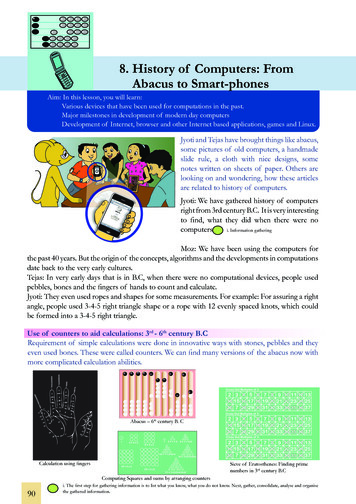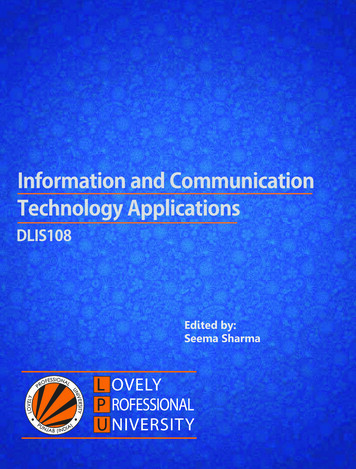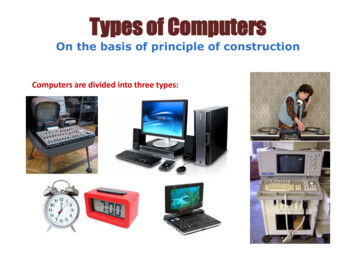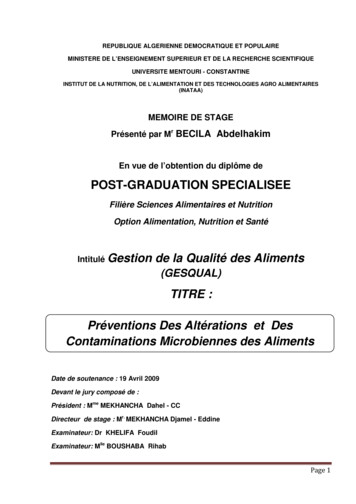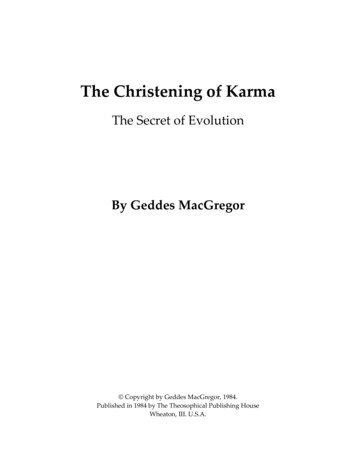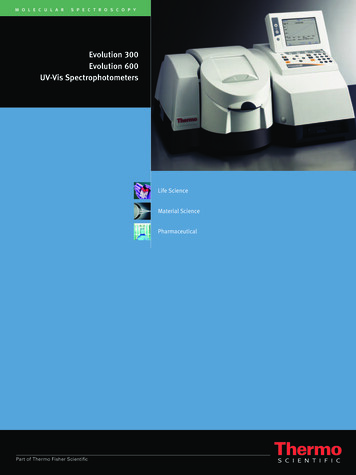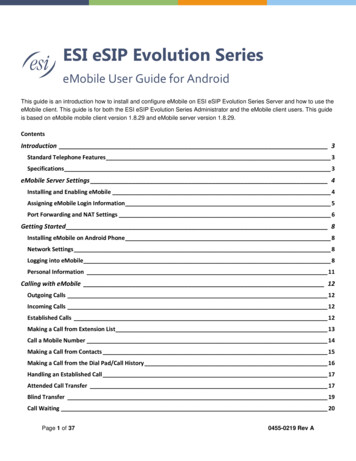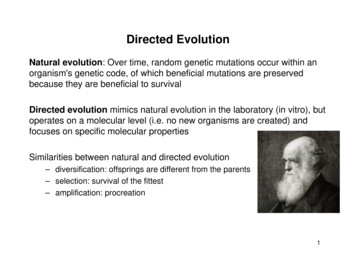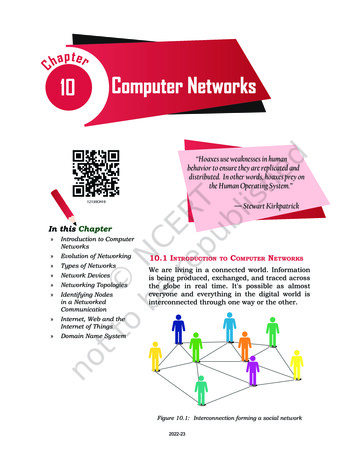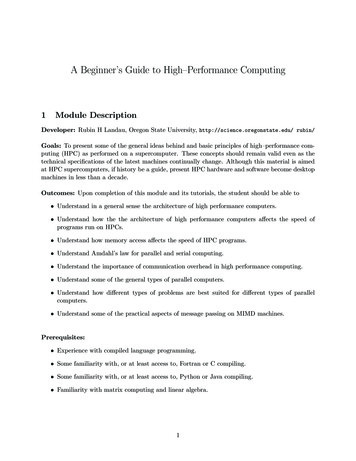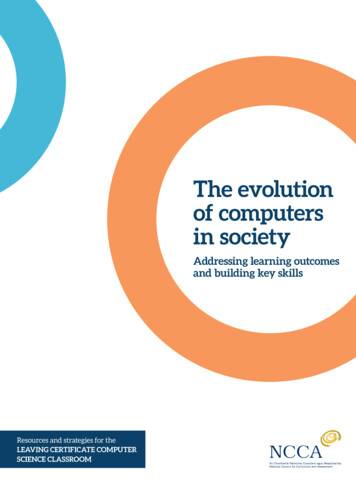
Transcription
The evolutionof computersin societyAddressing learning outcomesand building key skillsResources and strategies for theLEAVING CERTIFICATE COMPUTERSCIENCE CLASSROOM
ContentsOverview . . . . . . . . . . . . . . . . . . . . . . . . . . . . . . . . . . . . . . . . . . . . . . . . . . . . . . . . . . . . . . . . . . . . . . . . . 3Early Computers and Computing Technology . . . . . . . . . . . . . . . . . . . . . . . . . . . . . . . . . . . . . 61936: The Turing Machine . . . . . . . . . . . . . . . . . . . . . . . . . . . . . . . . . . . . . . . . . . . . . . . . . . . . . . . . . 81942–1946: First Electronic Computers: Colossus and ENIAC . . . . . . . . . . . . . . . . . . . . . . . . 151947: Solid State Transistors . . . . . . . . . . . . . . . . . . . . . . . . . . . . . . . . . . . . . . . . . . . . . . . . . . . . . . 201953: Invention of High Level Programming Languages . . . . . . . . . . . . . . . . . . . . . . . . . . 241958: Integrated Circuits . . . . . . . . . . . . . . . . . . . . . . . . . . . . . . . . . . . . . . . . . . . . . . . . . . . . . . . . . . 311973: Mobile Phones and Interconnected Computers . . . . . . . . . . . . . . . . . . . . . . . . . . . . . 361977: First Modern PC – Apple II . . . . . . . . . . . . . . . . . . . . . . . . . . . . . . . . . . . . . . . . . . . . . . . . . . . 411989: The World Wide Web . . . . . . . . . . . . . . . . . . . . . . . . . . . . . . . . . . . . . . . . . . . . . . . . . . . . . . 462000–2020: Cloud Computing and the Smart Phone . . . . . . . . . . . . . . . . . . . . . . . . . . . . . . 53Emerging Trends in the 21st Century . . . . . . . . . . . . . . . . . . . . . . . . . . . . . . . . . . . . . . . . . . . . .57A Summary of Teaching & Facilitation Methodologies . . . . . . . . . . . . . . . . . . . . . . . . . . . 62
OverviewThe Leaving Certificate Computer Science (LCCS) specification is constructed into3 strands: Practices and principles, Core concepts and Computer science in practice.The learning outcomes are interwoven across the 3 strands. Many learning outcomesacross all 3 strands can be achieved through a blended pedagogy of group activitieswith guided exploration and creative problem solving.Suggestions on how to use this resourceThis resource aims to primarily support the learning outcomes around Computers and society, and the evolutionof computers in society, in strand 1, and also the core concept of Computer systems in strand 2.The resources and strategies provided are intended mainly for the teacher to use in the classroom. They canbe used in the context of an Applied learning task (ALT) or simply as classroom strategies to engage students inwider ethical and cultural questions. They are not prescriptive and the concepts do not have to be taught in theorder they are presented. Teachers will discover many other ways of helping their students achieve the learningoutcomes. Much of the learning around computers and society and the direction of technological developmentcan be facilitated by teachers with classroom techniques, such as Power of Persuasion, Think-Pair-Share-Snowballand Stimulate a Debate, which are described within this resource. There are also design and developmentactivities, plus ideas for other suitable activities. The resource itself, with guidance and differentiation from theteacher, can be used as a learning platform by students.Material that is suitable for Higher Level only is indicated by an orange bar to the side.The evolution of computers in society is outlined below. Each development in the evolution is used as a platformto study subsequent related developments. In this sense the learning outcomes can be achieved in an iterativeand non-linear fashion. The learning outcomes can be viewed at curriculum online.Computer Science – Evolution of Computers in Society3
100 Years of Computing Developments19361942–1946The Turing MachineFirst Electronic Computers:Colossus and ENIAC194719531958Solid State TransistorsInvention of High LevelProgramming LanguagesIntegrated Circuits197319771989Mobile Phones andInterconnected ComputersFirst modern PC –Apple IIThe World Wide WebEarly Computersand ComputingTechnology2000–2020Cloud Computingand the Smart PhoneEmerging trends in the 21st centuryComputer Science – Evolution of Computers in Society4
Encouraging successful groupworkHere are some ideas on how to set up and encourage effective groups.Heterogenous membersAvoid friendship groups. At the start, students may object to being separatedfrom their friends. Explain that the groups will change regularly. Groups couldbe generated randomly. Keep groups small to begin with.Social skills need to betaughtTeachers must teach the skills needed for group work, such as listening skills,leadership skills (shared and rotated), conflict resolution skills, how to givefeedback, how to encourage each other, etc. “Be Kind, specific, and helpful”(Berger)Ensure everyone feelsaccountable for their ownwork and for the work ofthe groupTeachers can ensure that the group is accountable while at the same timemaking sure that there is individual accountability. For example by randomlyselecting one student to explain the group’s answer or giving out role cards soit is clear who is the designer, reporter, communicator, etc.Create positiveinterdependenceThe teacher structures work in such a way that students need each other inorder to complete the task.This can be achieved: when the teacher sets a shared task or goal, and explains that all the groupmembers must be able explain how it was arrived at when resources are shared (one worksheet between each pair/small group) when the teacher requests one end product and there is a shared andnamed input from each memberBoth the task andrelationships are importantCooperative learning groups try to increase students’ learning and maintaingood working relationships. Students need to be reminded to observe how theyare succeeding with both.Make time for groupreflection/evaluationThe students need time to discuss how well they are achieving their goals andhow they are working together. Questions such as “What worked well in thegroup today?” and “How can you work better next time?” are useful.Adapted from Johnson, Johnson and Holubec, Cooperation in the Classroom.Computer Science – Evolution of Computers in Society5
Early Computersand ComputingTechnology19361942–194619471953The Turing MachineFirst Electronic Computers:Colossus and ENIACSolid State TransistorsInventiProgramEarly Computers andComputing TechnologyHumans have been trying to develop machines for a long time thatcan assist them with performing calculations and processing data.As populations grew and societies became more sophisticated overtime, the need to process data increased dramatically.The crash course of early computers traces these attempts from the abacus inventedover 4000 years ago in Mesopotamia up to Hollerith’s invention of punch cards in thelate 19th century.Two early 19th century pioneers of both the theory and mechanics of calculation wereCharles Babbage and Ada Lovelace. He devised a general purpose machine which hecalled an Analytical Engine. Lovelace realised the potential of such a machine beyondcalculations and published the first algorithm intended for a computer.The 19th century saw the invention of the telegraph and the telephone, Maxwellpredicted radio waves to exist and published his laws of electromagnetism culminatingin Marconi’s transmission of radio waves across the Atlantic in 1901. By the 1920sautomobiles had becomes affordable and the first modern electronic television wasinvented. Communication and travel were being revolutionised. The informationrevolution was about to begin.Explore a timeline of the history of computers and computing technology from the1930s to the present day.Computer Science – Evolution of Computers in Society6
Early Computersand ComputingTechnology19361942–194619471953The Turing MachineFirst Electronic Computers:Colossus and ENIACSolid State TransistorsInventiProgramSome questions to considerThere are some fundamental questions teachers and students should ask themselves asjourney through the evolution of computers in society. Computational Thinking is humans solving problems, knowing that a computer is inthe wings with processing power far in excess of human processing power. But thepower of computers has increased exponentially. Ask yourself: Does computational thinking change in nature as processing powerchanges? Start-up companies no longer have to begin in offices. They can start in the homesof friends, computer clubs or famously people’s garages. The Personal Computerand the digital revolution have empowered people to become entrepreneurs andprogrammers. People who have been disabled are being increasingly enabled by newempowering technologies. Ask yourself: How has this empowerment become possible over the last century andwill it last? Ask yourself: What is the role of adaptive technology in the lives of all human beings? The digital revolution, particularly in the 21st century, has been called a disrupterof both business and of society. Major multinational hi-tech companies haveestablished new models for calling a taxi, booking a hotel, staying in Bed andBreakfasts, booking a table in a restaurant and then distributing the food we don’teat. Ask yourself:What are the positive and negative impacts of computing on culture andsociety? Some innovations are a natural evolution from previous developments. Howeversometimes a new innovation startles the world, and is more revolution thanevolution. Ask yourself: How does the power of computing enable different solutions to difficultproblems?Computer Science – Evolution of Computers in Society7
Early Computersand ComputingTechnology19361942–194619471953The Turing MachineFirst Electronic Computers:Colossus and ENIACSolid State TransistorsInventiProgram1936The Turing MachineLearning Outcomes addressed in this section are listed below.1.7 develop algorithms to implement key lent chosen solutions1.12 compare the positive and negative impacts of computing on culture and society1.13 identify important computing developments that have taken place in the last100 years and consider emerging trends that could shape future computingtechnologies1.14 explain when and what machine learning and AI algorithms might be used incertain contexts1.18 recognise the diverse roles and careers that use computing technologies2.5 use pseudo code to outline the functionality of an algorithm2.8 apply basic search and sorting algorithms and describe the limitations andadvantages of each algorithmCharles BabbageWhen other Learning Outcomes are addressed, for instance in classroom activities orthrough related online resources, the LO is numbered.Computer Science – Evolution of Computers in Society8
Early Computersand ComputingTechnology19361942–194619471953The Turing MachineFirst Electronic Computers:Colossus and ENIACSolid State TransistorsInventiProgramThe birth of Computer Science and Machine Learning can be traced back to manyideas and early prototypes, such as Babbage’s calculating machine in the early 19thcentury or Hollerith’s punch card system from the end of the 19th century. There ishowever a strong case that Alan Turing’s machine laid the foundations for thedevelopment of Computer Science and Machine Learning.In 1936, Alan Turing invented a mathematical model of a universal machine, whichlater became known as a Turing Machine.The operation of the machine is a simple concept.Despite its apparent simplicity, a Turing Machine can be constructed to solve any givencomputer algorithm.1 It is in this sense, the first concept of a universal, all-purpose,computing machine. It provides computer science with a firm scientific foundation, sinceit offers a model of computation which can be tested against real world applications.How to explain theimportance of the TuringMachine? Visit runestoneacademy Use the classroomunplugged activity belowto perform the addition of1 2 on a Turing Machine.LO 1.3–1.8, 1.13LO 2.5 Classroom ActivityTo demonstrate an algorithm on the Turing Machine with an unplugged version ofthe addition of two numbers.A Turing Machine can, in theory, execute any algorithm a modern computercan execute. The Turing Machine, shown below, consists of an infinitely longpaper tape comprising an infinite number of cells. A read/write head pointsto a particular cell at any given time. There are only 3 operations that can beperformed on the tape:1. Read the value2. Write a new value (0,1, BLANK)3. Move the read/write head to the next cell.Learn how to assembleanother unpluggedalgorithm.An unplugged punchcard lesson, with videodemonstration. From theteachinglondoncomputingwebsite.LO 1.7LO 2.8The # symbol in the diagram below will be interpreted in this case as ADD. Themachine itself is oblivious to the symbol, as the algorithm is deciding that # in thiscase means addition. An example of the steps of an algorithm to perform 2 3 areoutlined below. The values, 2 and 3, are bookended by blanks. We want to end ourexecution of the algorithm with five 1’s in a row, bookended by BLANKs.Demonstrate the operation of the pseudocode below to students before assigningroles.1Sipser (2006) Introduction to the Theory of Computation Thomson Course Technology, USA.Computer Science – Evolution of Computers in Society9
Early Computersand ComputingTechnology19361942–194619471953The Turing MachineFirst Electronic Computers:Colossus and ENIACSolid State TransistorsInventiProgram1. Draw a representation of the infinite tape on a whiteboard (or any displayboard). The initial state is shown Read/Write Head2. Move LEFT; Read the value;REPEAT until the value BLANK {Write 0;Move LEFT;Read the value;}Current00#1110#1113. Move RIGHT; Write a BLANK;Move RIGHT; Read the value;Current4. REPEAT until the value 1 {Write 1;Move RIGHT;Read the mputer Science – Evolution of Computers in Society111110
Early Computersand ComputingTechnology19361942–194619471953The Turing MachineFirst Electronic Computers:Colossus and ENIACSolid State TransistorsInventiProgramThe classroom activity requires 3 students to execute individual operations at thewhiteboard. Another group, which could be the rest of the class, ensure the stepsof the algorithm are carried out correctly. They are the control unit.The 3 people with specific individual roles are:The READER Turing MachineAddition ActivityThe activity addresses arange of LOs.In particular:The role is to read the value in the cell where the read/write head is pointing. TheReader must read out the value from the whiteboard as instructed, even if thealgorithm is operating incorrectly. ComputationalThinking LOs in Strand1 (LO 1.1–1.10)The WRITER Computers and SocietyLOs in Strand 2(LO 1.13–1.14)The role is to write a value into the cell where the read/write head is pointing. Thestate of the Turing machine will be updated by the writer on the whiteboard.The read/write HEADThe role is to re-draw the position of the read/write head on the whiteboard,according to the instructions issued by the control unit. The head can berepresented by the shape shown in the example, or any similar symbol that isappropriate.The challenge is to carry out the addition of any two natural numbers. Forexample, 2 1 or 2 5 or 3 3.A further challenge, at an appropriate stage of the course, could be to program thealgorithm in Python or JS with a suitable UI, to carry the out the addition of anytwo user-defined natural numbers.Computer Science – Evolution of Computers in Society Algorithm LOs inStrand 2 (LO 2.5–2.7)Watch a video showingbasic arithmetic on theTuring machine. Thealgorithm for addition is inthe first minute.Explain how it is differentto the algorithm in theclassroom activity.11
Early Computersand ComputingTechnology19361942–194619471953The Turing MachineFirst Electronic Computers:Colossus and ENIACSolid State TransistorsInventiProgramBrain BusterAlan Turing was also fascinated by such a machine’s ability to thinkAfter reading the quote inthe Brain Buster, was AlanTuring’s belief correct?Facilitate a walkingdebate or TPSS activity.LO 1.13, 1.14“The original question, “Can machines think?”, I believe toomeaningless to deserve discussion. Nevertheless I believethat at the end of the century the use of words and generaleducated opinion will have altered so much that one will beable to speak of machines thinking without expecting to becontradicted.”Computing Machinery and Intelligence. Turing (1950)What is Artificial Intelligence (AI)?Humans have been thinking about AI for many centuries. The term ArtificialIntelligence was only coined in 1955 by John McCarthy as: “the science and engineeringof making intelligent machines.” The following year, 1956, it was founded as an area ofacademic research during a workshop in Dartmouth College.2 The goal of AI is to teachcomputers to do things that humans do, only better. One of those key things is learning.Machine Learning is therefore in some ways a subset of AI, but it has grown so rapidlyin the early 21st century that some people argue it has outgrown AI.Machine Learning (ML) AlgorithmsAlan Turing was alsofamous for the Turing test.Can you tell the AI fromthe human in these shortbreakthrough phone callsreleased at a Google IOevent in 2018?What do you think theT in the abbreviationCAPTCHA stands for?There are 2 broad categories of ML: supervised and unsupervised. For example, let’sconsider items needing to be sorted into waste and recyclables. Supervised learningwould require humans to examine the categorisation performed by the algorithmand tell the algorithm, using labels, which items have been incorrectly sorted. Anunsupervised algorithm will identify patterns in both the input and output, perhapscorrelating existing categorisation, with statistical analysis, to sort the items. Bothsystems improve, but in different ways.2https://en.wikipedia.org/wiki/History of artificial intelligenceComputer Science – Evolution of Computers in Society12
Early Computersand ComputingTechnology19361942–194619471953The Turing MachineFirst Electronic Computers:Colossus and ENIACSolid State TransistorsInventiProgramThe following links give 3 examples of each of the 2 main categories of MachineLearning.Supervised Learning uses training (input) data and if certain outputs are incorrect,the algorithm is notified not to output this in future. It relies on good data and somefeedback.Unsupervised Learning allows the algorithm to spot patterns and decide itself whichoutputs are most useful. It does not rely on feedback.Within these categories there are five popular schools of machine learningalgorithms3:1. SYMBOLISTSThis is closely related to mathematical thinking. They believe all intelligence canbe reduced to manipulating symbols. By combining pre-existing knowledge withnew data, and incorporating it into the machine, new learning will take place.2. CONNECTIONISTSThis is related to neuroscience. They believe that strengthening connectionsbetween neurons/logic gates will improve the machine’s learning and similarlyeliminating connections that cause errors in outputs. By looking at the output andcomparing it to the correct output, the connections that require modification canbe identified. This is known as backpropagation.3. EVOLUTIONARIESThis is related to evolution by natural selection. The concept of geneticprogramming is very strong where the best programs are merged togetherevolving into better programs. The less successful programs are disposed ofcreating a constantly evolving structure capable of new learning.LearningOpportunity: Thetypes and uses ofMachine Learning Watch an indepth video on thecategories and uses ofMachine Learning.Now examine anddiscuss whenmachine learningand AI algorithmsmight be used incertain contexts.LO 1.144. BAYESIANSThis is related to a theorem in probability called Bayes Theorem. Bayesians,using probability, combine new evidence with existing beliefs to infer new ideas.Learning itself, they believe, is uncertain knowledge.5. ANALOGISERSBy comparing two things which have similarities, perhaps other characteristicsare similar. For example if two patients share symptoms, perhaps they have thesame underlying illness. By remembering the correct situations, and combiningthose things that are similar, new learning can be achieved.3Domingos (2015) The Master Algorithm Penguin BooksComputer Science – Evolution of Computers in Society13
Early Computersand ComputingTechnology19361942–194619471953The Turing MachineFirst Electronic Computers:Colossus and ENIACSolid State TransistorsInventiProgramWhat is Driving the AI and Machine LearningExpansion?AI and Machine Learning systems have been around for decades yet the self-drivingcar, for example, has only become a possibility in the second decade of the 21st century.Why? Why this seemingly sudden explosion. Have humans become better at designing algorithms? Is a computer’s processing of the real world now approximating a human’s? Are there more quantities of useful data available to humans and computers? Is the rapid expansion going to continue? What are the emerging trends?Predicting future trends and technologies is extremely difficult.Data, Algorithms andProcessing PowerTake the Crash Courseon AI and MachineLearning.Facilitate a discussionaround the rapid expansionof AI technologies, andthe reasons behind theexpansion.LO 1.13, 1.14In 1973, the invention of wifi and radio technology made mobile phones possible.One trend being widelypredicted is the area ofquantum computing. Watch a short video onQuantum Computing.How difficult would it have been back then, to predict the future technologies available40 years later in 2013? In 40 years time how will technology shape our world? Whattrends will underpin that technology. Classical versusQuantum Computers.a 10 minute explanation.“The bits explosion is not over. We are in the middle of it. But we don’t know whether itwill be destructive or enlightening. The time for deciding who will control the explosionmay soon be past. Bits are still a new phenomenon — a new natural resource whoseregulatory structures and corporate ownership are still up for grabs. The legal andeconomic decisions being made today, not just about bits but about everything thatdepends on bits, will determine how our descendants will lead their lives. The way thebits illuminate or distort the world will shape the future of humanity.” 4LO 1.13, 1.144Abelson, Ledeen, Lewis (2008) Blown to Bits Addison-Wesley.Computer Science – Evolution of Computers in Society14
Early Computersand ComputingTechnology19361942–194619471953The Turing MachineFirst Electronic Computers:Colossus and ENIACSolid State TransistorsInventiProgram1942–1946First Electronic Computers:Colossus and ENIACLearning Outcomes addressed in this section are listed below.1.11 discuss the complex relationship between computing technologies and societyincluding issues of ethics1.12 compare the positive and negative impacts of computing on culture and society1.13 identify important computing developments that have taken place in the last100 years and consider emerging trends that could shape future computingtechnologies1.18 recognise the diverse roles and careers that use computing technologies2.11 describe the different components within a computer and the function of thosecomponentsWhen other Learning Outcomes are addressed, for instance in classroom activities orthrough related online resources, the LO is numbered.Computer Science – Evolution of Computers in Society15
Early Computersand ComputingTechnology19361942–194619471953The Turing MachineFirst Electronic Computers:Colossus and ENIACSolid State TransistorsInventiProgramWhat constitutes a computer? Charles Babbage designed a mechanical computingmachine called the Difference Engine, in 1822. Babbage’s later concept for an AnalyticalEngine is considered the first general mechanical computer comprising a basicprocessing and storage of data. In addition Ada Lovelace published an algorithm for themachine and showed it could be programmed by punch cards. In the late 1930s KonradZuse designed the Z1, an electro-mechanical programmable computer. The HarvardMark 1 was a more sophisticated version which was first programmed by John vonNeumann at the end of World War II. However the Colossus was the first fullyprogrammable electric computer. Invented and designed by Tommy Flowers and AlanTuring, it made a major contribution to ending WWII when it helped to crack the codesof Nazi encryption machines. Simultaneously in the USA, Eckert and Mauchly built theENIAC (Electronic Numerical Integrator and Computer), which is often considered to bethe first example of a general purpose digital computer.The components of the first programmable computersThe ENIACThe first electronic computers, Colossus andENIAC, weighed tons, occupied large rooms,and before the invention of semiconductingtransistors, switching was executed byvacuum tubes (thermionic valves). Militaryadvances during WWII spurred innovationand fast-tracked the invention of the ENIAC.The Colossus was re-built in Bletchley Park,the top secret British site of WWIIdecryption. It went live on 6th June 1996. Watch this Computerphile tour of theoperation of the machine.The Babbage analytical machine, as explained in the video on the evolution ofcomputing devices, had 4 revolutionary features: Input, Storage, Processing and Outputcomponents. Sequential flow control and looping operations were fundamental to hisconcept. Today, the inside of modern computers is not that different. Watch a short video onthe evolution of computingdevices. What 4 features of theBabbage machine madeit revolutionary? Name components thatact as switches? What was the firstmicroprocessor usedfor?Explore the Human BrainProject website to see thelatest advances in how ourbrains could be simulated.LO 1.13LO 2.11 From Enigma to ENIACand John von Neumann’scontribution to themodern programmablecomputer. The first useof computers in 1952 topredict US election results.The history anddevelopment of theENIAC (0–7:44) and thepath forward after WWII(7:44–12:47)LO 1.11LO 2.11Computer Science – Evolution of Computers in Society16
Early Computersand ComputingTechnology19361942–194619471953The Turing MachineFirst Electronic Computers:Colossus and ENIACSolid State TransistorsInventiProgramThe Arithmetic Logic Unit (ALU), where instructions are actually carried out, isprobably the only functional unit that is extra to the original concept, as shown inthe schematic block diagram below.CPUINPUTARITHMETICLOGIC UNITABSTRACTEDMODEL OFCOMPUTERCOMPONENTS(Block Diagram)CONTROL UNITOUTPUTMEMORYThe complex relationship between society and computing technology is demonstratedclearly through the invention of the Colossus and ENIAC. The Colossus had a realimpact on the war, shortening it by 2 or 3 years.5 Processing data, encrypting anddeciphering codes and crunching numbers became key factors in deciding the outcomeof WWII.Would the first electronic computers have evolved so rapidly, almost independently ofeach other, without the impetus of a world at war? Many military innovations becomemainstream technologies. For example, the US Defence Advanced Research ProjectsAgency (DARPA) developed the Arpanet6 in the late 1960s. It connected 4 nodes in theUSA, developed IP addresses and invented TCP and UDP networking protocols. In the1980s it evolved into the Internet.5BBC homepage and news http://www.bbc.com/news/technology-184196916Wang (2016) From Computing to Computational Thinking CRC Press (p 97–98).Computer Science – Evolution of Computers in Society17
Early Computersand ComputingTechnology19361942–194619471953The Turing MachineFirst Electronic Computers:Colossus and ENIACSolid State TransistorsInventiProgramHowever ethics and computing technology spreads into our everyday life. The cogglemindmap below delves into all the areas where people, society and business must thinknot just about “Can I do this?” but “Should I do this?”.Lots of websites suitable for LCCS that explore computers and society can be filtered onwww.compsci.ie.– Do not leave the computer running overnight.– Use recycle paper.– Who provided the information and for whatpurpose?criteria to evaluate theINFORMATION ACCURACYaccuracy of information:– How old is the information?GREEN COMPUTING Ways to implementgreen computing:– Does the site provide the reference to data?– Use paperless method to communicate.– Turn off the monitor, printer, and other deviceswhen not in use.focuses on reducing theelectricity and environmental waste whileusing a computer.unique andoriginal works such as ideas, inventions, arts,writings, processes, product names, and logos.INTELLECTUAL PROPERTY– Copyright – for artistic and literary works– Patent – for inventions– Trademark – for signs, logo, sloganAREAS OF COMPUTERS ETHICS 3 types of Intellectual Property Rights:rights ofindividuals and companies todeny or restrictthe collection and use ofinformation aboutthem.– Cookies – a small text file that web server storeson your computer– Phishing – a scam using email to get personal andfinancial information– Electronic profiles – data collected when you fill aform or
of computers in society, in strand 1, and also the core concept of Computer systems in strand 2. The resources and strategies provided are intended mainly for the teacher to use in the classroom. They can be used in the context of an Applied learning task (ALT) or simply as classroom strategies to engage students in


